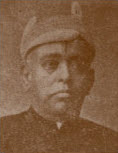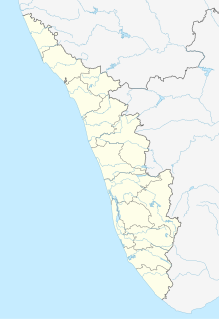
The Kingdom of Travancore (Thiruvithamkoor) was an Indian kingdom from 1500 until 1949. It was ruled by the Travancore Royal Family from Padmanabhapuram, and later Thiruvananthapuram. At its zenith, the kingdom covered most of modern-day central and southern Kerala with the Thachudaya Kaimal's enclave of Irinjalakuda Koodalmanikkam temple in the neighbouring Kingdom of Cochin, as well as the district of Kanyakumari, now in the Indian state of Tamil Nadu. The official flag of the state was red with a dextrally-coiled silver conch shell at its center. In the early 19th century, the kingdom became a princely state of the British Empire. The Travancore Government took many progressive steps on the socio-economic front and during the reign of Maharajah Sri Chithira Thirunal Balarama Varma, Travancore became the second most prosperous princely state in British India, with reputed achievements in education, political administration, public work and social reforms.

Sree Padmanabhadasa Sree Chithira Thirunal Balarama Varma, popularly known as Sree Chithira Thirunal, was the last ruling Maharaja of the Princely State of Travancore, in southern India until 1949 and later the Titular Maharajah of Travancore until 1991. Sree Chithira Thirunal was the eldest son of Junior Maharani of Travancore, H.H. Sree Padmanabhasevini Vanchidharmavardhini Rajarajeshwari Maharani Moolam Thirunal Sethu Parvathi Bayi, and Sri Pooram Nal Ravi Varma Koyi Thampuran of the Royal House of Kilimanoor. He was privately educated, and became the Maharajah of Travancore, at the age of 12, upon the death of his maternal great uncle, the then Maharajah of Travancore Sree Moolam Thirunal, on 7 August 1924. He reigned under the regency of his maternal aunt, Sethu Lakshmi Bayi (1924–31), until he came of age and was invested with full ruling powers on 6 November 1931.

Pattom Thanu Pillai was a participant in the Indian independence movement who later served as the Chief Minister of Kerala from 22 February 1960 to 25 September 1962. He was known as the 'Bhishmacharya' of Kerala politics.

The High Court of Kerala is the highest court in the Indian state of Kerala and in the Union Territory of Lakshadweep. It is located in Kochi. Drawing its powers under Article 226 of the Constitution of India, the High Court has the power to issue directions, orders and writs including the writs of habeas corpus, mandamus, prohibition, quo warranto and certiorari for ensuring the enforcement of the Fundamental Rights guaranteed by the Constitution to citizens or for other specified purposes. The High Court is empowered with original, appellate and revisional jurisdiction in civil as well as criminal matters, and the power to answer references to it under some statutes. The High Court has the superintendence and visitorial jurisdiction over all courts and tribunals of inferior jurisdiction covered under its territorial jurisdiction.
Thottakkattu Madhavi Amma was one of the founding members of the first (1925) legislative council of the erstwhile state of Kochi, in India. She was the daughter of Diwan Peshkar of Cochin and the famous poet Thottakattu Ikkavamma. Madhavi Amma was the first woman to be an elected member of any legislature in India. She was married to Mannathu Padmanabhan, the veteran social reformer.
Paravoor T. K. Narayana Pillai was an Indian freedom fighter during the British Raj in India and was a member of the Indian National Congress (INC) which fought against the British rule in India. He was the last Prime Minister of Travancore and the first Chief Minister of Travancore-Cochin at the time of its formation in 1949. He was commonly known as Parur TK.

Pandit Karuppan was a poet, dramatist, and social reformer who lived in Kerala, India.

Kochi is a small city located in the Ernakulam District in the Indian state of Kerala. Trivandrum which is the capital and largest city of Kerala is 200km away from Kochi.

Diwan Bahadur Sir Perungavur Rajagopalachari, KCSI, CIE, also spelt in contemporary records as Sir P. Rajagopala Achariyar, was an Indian administrator. He was the Diwan of Cochin State from December 1896 to August 1901 and of Travancore from 1906 to 1914.
Government Law College, Thiruvananthapuram at University of Kerala is one of the prestigious institutions imparting undergraduate and graduate legal education in India.

Panampilly Govinda Menon was an Indian politician, freedom fighter, and lawyer.

The Government Law College, Ernakulam is an institution for undergraduate, graduate and post-graduate legal education in the city of Kochi, Kerala, India. Founded in 1874, it is the first law college in the state of Kerala and also one of the oldest law colleges in India. The college is affiliated to the Mahatma Gandhi University in Kottayam. The College is a recognised Research Centre in Law under the Mahatma Gandhi University, Kottayam since 2010. The college, which is a premier institution of legal education in Kerala, has a prestigious list of alumni including K.G. Balakrishnan, Mammootty, A K Antony and Oommen Chandy. It is popularly known as Ernakulam Law College (എറണാകുളം ലോ കോളേജ്) or Maharajas Law College.
Diwan Bahadur Sir Mannath Krishnan Nair KCIE (1870–1938) was an Indian politician from the Indian National Congress and later, Justice Party who served as a member of the Madras Legislative Council and later, executive council of the Governor of Madras. He also served as the Chief Justice of Travancore High Court and later Diwan of Travancore from 1914 to 1920
Thottakattu Sankunni Menon CSI, also spelt as Shungoony Menon, was an Indian civil servant and administrator who served as the Diwan of the Cochin kingdom from 1860 to 1879. His administration is recognized as a period of development. Sankunni Menon's brother T. Govinda Menon also served as Diwan from 1879 to 1889.
Thottakattu Govinda Menon was an Indian civil servant and administrator who served as the Diwan of Cochin kingdom from 1879 to 1890. He was the younger brother of T. Sankunni Menon. It was during his tenure that the border between Cochin and Travancore kingdoms was settled.
Thaikkattusery Sankara Warrier was an Indian civil servant and administrator who served as the Diwan of the Kingdom of Cochin from 1840 to 1856. His sons T. Sankunni Menon and T. Govindan Menon have also served as Diwans of Cochin.

V.R.Krishnan Ezhuthachan (1909–2004) was an Indian freedom fighter, Gandhian, journalist, trade unionist and Indian National Congress leader from Thrissur city in Kerala, India. Ezhuthachan was the founder general secretary of Kochi rajaya prajamandalam which was constituted on 26 January 1941. He is also founder of the now defunct Deenabandhu daily published from Thrissur..
K.P. Padhmanabha Menon (1857-1919) was an Indian historian, He was born in Elamakkara near Edappally in October 1857. He was the son of 'Diwan peshkar' P.Sankunny Menon author of Travancore history. K.P. Padhmanabha Menon's History of Kerala in four volumes with 2,500 pages was completed in 1910. Padmanabha Menon used a portion of the Aluva Palace for this work. The work was published in 1924, five years after his death.










